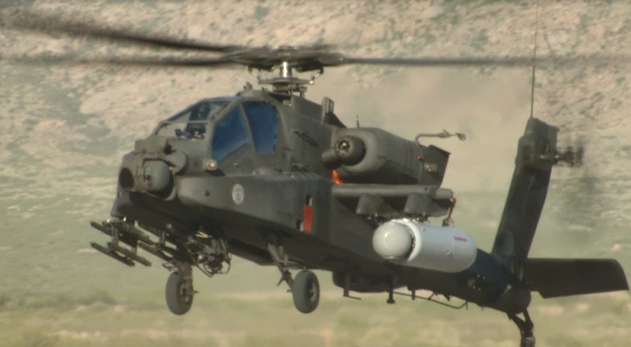“…Not until they invent handheld laser beams or something” – maybe you’ve heard this tacked on the end of an argument about how small arms are at their peak, and unlikely to change very much anytime soon. Well, the day when Star Wars-style blasters become a reality may be sooner than some think: Military technology giant Raytheon has conducted the first comprehensive flight test of a helicopter-borne high energy laser weapon capable of blasting drones out of the sky.
According to Raytheon’s press release, the laser was mounted to the AH-64 Apache attack helicopter, which took off and then conducted targeting and firing tests in multiple flight regimes, airspeeds, and altitudes, and signaled a major milestone in proving the feasibility of helicopter-mounted laser weapons. The company also released a brief video of the test:
Veteran website Task & Purpose shed more light on the program, and the decision to use the Apache for testing:
Raytheon has been working with the Army’s Apache Program Management Office on the Apache integration since at least May 2016. Speaking at an industry conference then, SOCOM Rotary Wing program chief Col. John Vannoy characterized the directed energy weapons initiative as a relatively inexpensive alternative to guided missiles and other munitions, a program that fits with Air Force Special Operations Command’s plans to outfit an AC-130J Ghostrider with an integrated laser system.
“We’re not at the point where we’ve laid out a business case to advance it,” Col. Vannoy said of aircraft-integrated laser systems. “We really want to understand the environment on the wing, the beam quality we can get off the wing and the ability to beam steer and keep power on a target.” Why the Army and SOCOM went with the Apache for such testing is unclear, especially given that, as Popular Mechanics points out, the command doesn’t typically utilize Apaches.
For special operations forces’ needs, slapping a bunch of laser cannons on an attack copter may prove more instructive than raining down an energy beam from a fixed-wing gunship high above the battlefield. The rotary-wing aircraft typically employed by SOCOM tend to engage targets within close range, cutting down on the factors — required energy, atmospheric dispersion, and the interference of dust and sand that can wreak havoc on laser-guided munitions — that could render a laser weapon ineffective.
I recommend our readers click through and read the entire article, as it contains a lot of additional detail.
Perhaps the most stubborn challenge in designing mobile laser weapons is the power source. By weight and volume, electrical energy sources like batteries are far, far less potent than chemical sources like gasoline or nitrocellulose smokeless powder, restricting the mobility of powerful lasers for now. However, as technology improves, it seems almost inevitable that some day handheld high energy lasers will be feasible weapons, even if it’s not any time soon. As this Raytheon test demonstrates, though, strides in this are are being made more quickly than many might think. Could infantry lasers be possible before the end of this century, or even sooner? It seems unlikely now, but who knows what advances the next 80+ years will bring.
Thanks to Ramlaen for the tip!
 Your Privacy Choices
Your Privacy Choices
